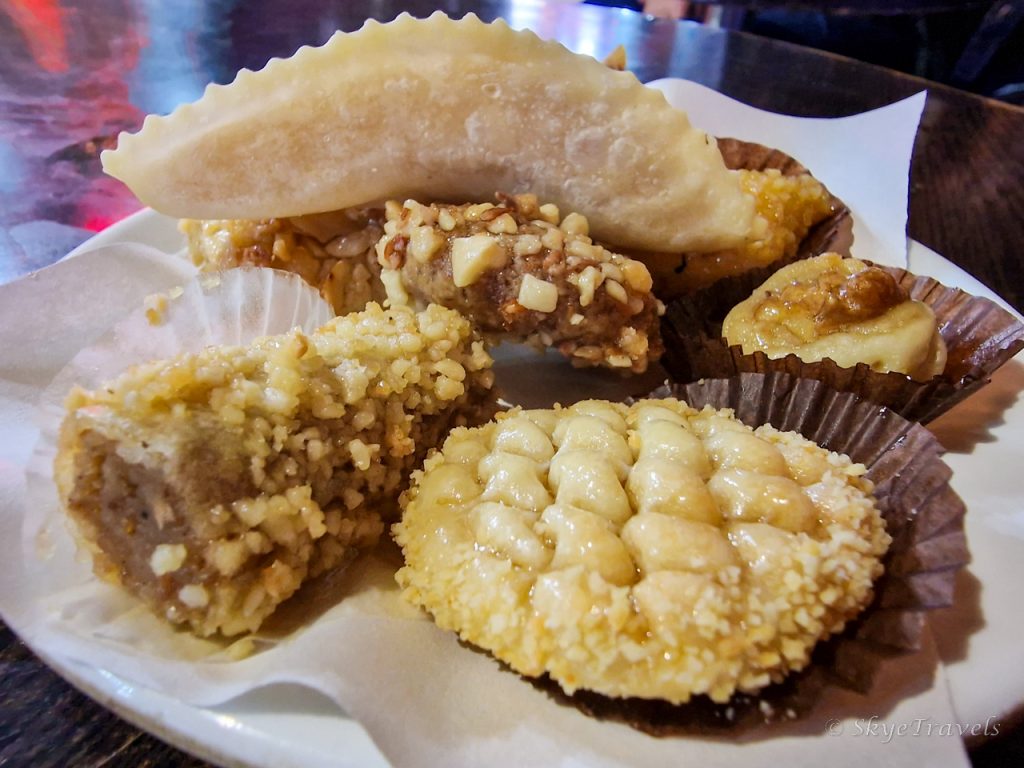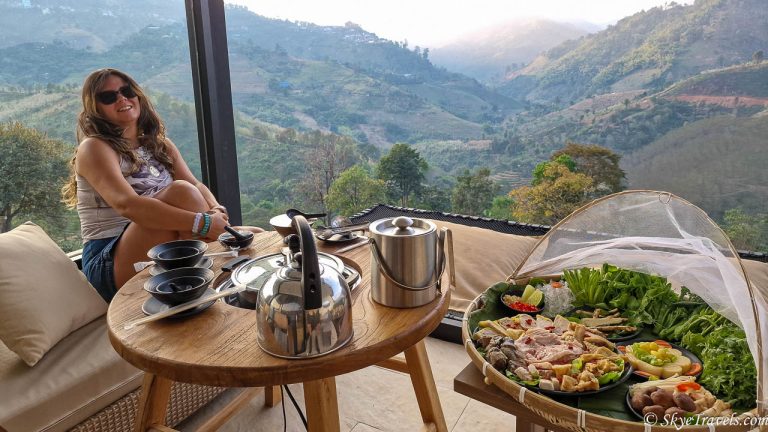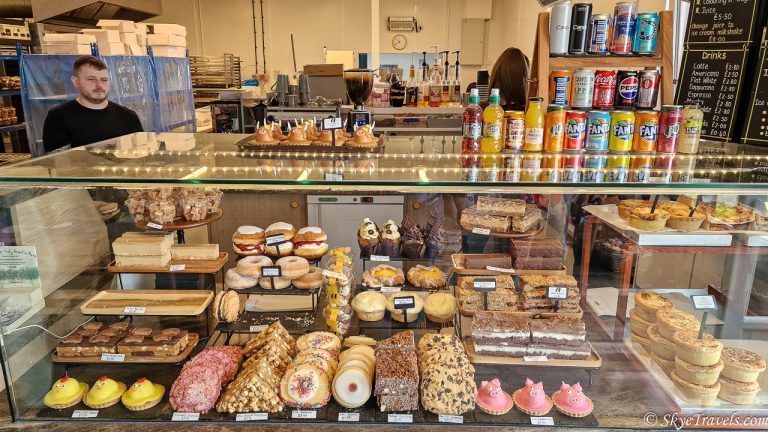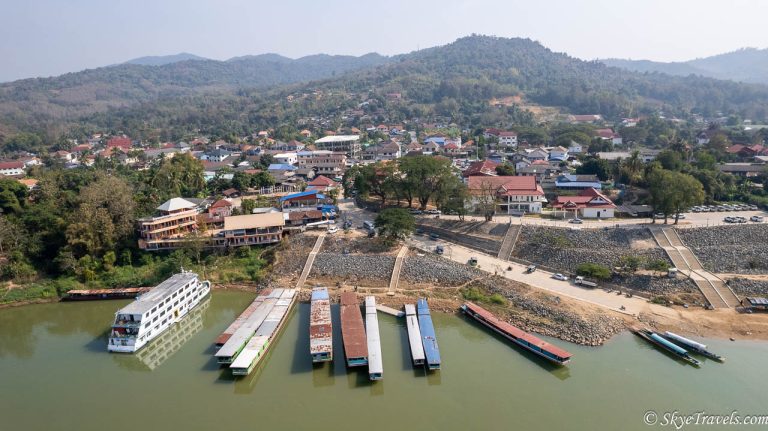As a food tour guide myself, I will always say that food tours are the best way to explore a new city and culture. Marrakech was no exception. On my second visit, Vanesa and I booked a Moroccan food tour with Marrakech Food Tours. I was quite surprised by some of the dishes we tried, and in absolute heaven with others. Here are the dishes from our tour, and some of the tidbits I learned along the route.
Starting with Mechoui Prepared Underground
Our guide Said met us in Jamaa El-Fna, the central square of Marrakech, where we were joined by an American family. After introductions and ascertaining that we didn’t have any dietary restrictions or intolerances, we were led across the square to our first stop.

A few steps north of the square are a group of food stalls collectively labeled Mechoui on Google Maps. Mechoui, or meshwi, is a spit-roasted lamb dish from northern Africa. The establishments we went to had a huge underground oven beneath the small dining area where they could roast thirty to forty sheep at a time, all arranged upright on their spits in the pit.

The meat was served in tangia urns. Unlike how lamb is normally quite tough, this just dissolved in my mouth. I loved it! However, I wasn’t entirely thrilled by the whole sheep head they brought out for the tongue and brains. Vanesa, on the other hand, enjoyed the tongue quite a bit as it’s similar to what she used to eat in Argentina.

Streetfood Samples in the Souk
Our next stop was a vendor in the souk serving olives, pickled onions, pickled lemons, and just about every other pickled fruit and vegetable we could have imagined. I’m someone who particularly loves olives – I’ll put black olives on everything – and I was more than happy with every sample we were given.

I also really enjoyed the harissa spice sample. Morocco is known for spices, particularly saffron. Harissa is the main spice they use, and I made sure I picked some up before leaving Marrakech. I just forgot how spicy it was. Well, it’s not that spicy, but when you use a couple of tablespoons to make chili at home, the chili has quite a kick.
Proper Harira, M’semen and a Special Pastilla
I’ve long since learned that often the best establishments are the most nondescript. The next place we visited was the perfect example. At the entrance was a woman making roti-like pastries with her bare hands, while a man next to her tended a huge pot of harira soup. The room beyond was sparse, with only a couple of simple, white tables. The prices were also what you would expect the locals to pay rather than crazy tourist prices.
The soup was incredible. I’d once attempted to make harira at home, but this one was way better. Harira is a soup with lamb, tomatoes, lentils, chickpeas, and Moroccan seasoning. It’s typically served as the first meal each night during Ramadan to break the fast.

I also loved the m’semen pastry that went along with it. The roti-like pastry was filled with onions and other spices. I was surprised I hadn’t tried it yet in Morocco, although I’d seen it several times at different street food vendors. At one point, Said went off to find a special item for us. I’d mentioned how much I loved pastilla when the tour started, and he found a bakery nearby that had a great version of one. If we hadn’t been on a food tour, I’d happily have gone to the bakery for a full portion.

Sardine Burgers – My Least Favorite
Our next stop was my least favorite. Said wrote down the item as Kafte tlhout bsmen, which I believe is just the name the vendor gave to it as I can’t find any reference to it online. It’s essentially a sardine meatball served in a bun with salted butter, tomatoes, onions, and chopped olives. I suppose if you like sardines, you would probably enjoy the burger, but it was just too fishy for my liking. I’ve never been the biggest fan of sardines.

The group of food stalls where we had the burger turned out to be fantastic. We returned later in the week to a place called Dabachi chez Cherif. For less than $5 each (far cheaper than any tourist trap in town), we had a delicious meal, and the staff even brought out a free dessert for us! We wished we had eaten there more often. One week in Morocco isn’t nearly enough time!
Sfenj Donuts and Orange Cucumber Drink
The next item on the tour was fascinating just in its presentation. It seemed to be a group of doctors in white smocks making donuts on the street. Essentially, it’s a daily activity at the end of the workday when a group of men make sfenj, unsweetened donuts, at a temporary food stall. It was one of those small items I would normally walk right past without taking any interest in, and probably did as I’d passed by that spot of the market many times without noticeing the donuts.

We washed down the sfenj with a delicious cucumber and orange juice at another establishment, served in bowls rather than cups. In the heat of Marrakech, it was such a refreshing item. The Jamaa El-Fna square is full of juice stands, but the quality isn’t always the best. If you’re on the eastern side of the Medina, see if you can find Café Snack Ben Mansour.

Discovering the Communal Bakeries
One aspect of Morocco I never knew about until the food tour was the communal bakeries. Of course, once I learned about them, I found them all over the city. I love how any family can bring their own bread (or technically just the dough) to these bakeries, where it will be baked in massive ovens. It’s amazing how they can get dozens of orders a day, and keep them separate for each family.

Believe it or not, you can even bring just about any dish to the bakers to warm up in the large ovens for a small fee. But bread is certainly their forte, and I was amazed at how quickly they made dozens of loaves at a time. We even got to same some of the generic bread that was headed out to the restaurants. Bread is certainly a staple in Morocco, where you’ll rarely get served a meal without a loaf included. I just wish they also served a bit of butter on the side.
Couscous from the Souk Mama
Next, we made our way to a hidden section in the medina where we had the main course – an incredible chicken couscous served by two ladies known as the Souk Mama. We would never have found the place without our Moroccan food tour. They’re not even on Google Maps, but they’re somewhat of a local legend. If you want to find them, search beyond the entrance of the Nomad restaurant around here on Google Maps.
Couscous is certainly one of Morocco’s signature dishes, along with tagine (which wasn’t part of the tour). On my first visit to Marrakech, I found a hole-in-the-wall place called Naima Couscous, which was incredible. The Souk Mama was on par with that. The only problem was the portion we were served was enormous (just like at Naima), and we were already so full from all the other items on the tour that it was impossible for us to finish even half of it.

Making couscous is really an art. Souk Mama uses a double boiler to prepare the couscous separate from the meats and vegetables. The dish takes several hours to slow-cook everything. Apparently, you can get nearly any local dish at this stand, which is why the local workers love it so much and call them the Souk Mama.
Finishing with Traditional Pastries
Finally, we were brought back to the main square for a full selection of local pastries. These were similar to Turkish baklava, but with different flavors – mostly almonds and dates. On the tour, we were shown how Morocco has over 100 varieties of dates! Some of the pastries were a bit too sweet for my liking, and we were completely stuffed by this point of the tour, so most of the pastries went into my bag for our Merzouga tour.

To finish everything off, we had two small smoothies – one with mixed fruit and the other with avocado. As someone who doesn’t like alcohol, I absolutely love juices and smoothies, and I was very happy with those. Don’t get me wrong, I’m sure the juices in the main square are good, but these other vendors just seemed to find better-quality fruits.

There was one more dish we tried on the tour, although I gathered it wasn’t an official stop. At one point, we were passing by some steamed snails, which Said described as a local delicacy. He bought a bowl of them to pass around, and I was adventurous to try one. It certainly wasn’t bad, but probably not something I would end up purchasing on my own.

Booking a Moroccan Food Tour in Marrakech
I can’t recommend enough the Moroccan food tour with Marrakech Food Tours. Said was very knowledgeable about the dishes throughout the tour, but also presented a bunch of information about other good restaurants to eat at, the history of the Medina, etc. The tour is available to most dietary restrictions, although vegans would have to book a private tour.
The tour departs daily from Jamaa El-Fna Square at 6 p.m. The website states the tour is 3.5 hours long, but our tour was almost exactly 4.5 hours! Make sure to plan that into your schedule, as you won’t want to miss the last stops. Perhaps not all the tours run an hour over time, but I’m certainly glad ours did, as I would not have wanted to rush any of the stops.
Prices change over the years, and schedules sometimes do too, so just check the Marrakech Food Tours website for current prices and news. The company is delivering an Essaouira food tour as well, which includes transportation to the beautiful coastal town. I would have loved to do that tour myself, but we were in Morocco just a couple of weeks before the tour officially launched.

Further Reading
Headed to Morocco? Here are my other articles about my first 12-day adventure in the country.
- How Easy and Hard Getting Into Morocco Was for Me
- Marrakech Excursions: A Day Trip to the Coastal Town of Essaouira, Morocco
- A Fantastic African Desert Safari at the Merzouga Luxury Desert Camp
- What an Authentic Hammam for Men in Marrakech is Really Like
- A Complete Guide to Visiting Marrakech on a Budget
Here’s some extra reading to save hundreds on your next vacation or stage of your journey.
- 5 Steps to Book Cheap Flights
- Hostels: To Book or Not to Book
- Is Workaway Worth it for the Traveler?
This post may contain affiliate links. These links help give me the wherewithal to continue traveling at no additional cost to you. For more information, click here.







2 Comments
you should have dined at our cooking school, House of Fusion Marrakech..edgy, Moroccan, Fusion fooding…next time!
cheers, Edwina
Ooh, absolutely. Cooking classes are definitely on par with food tours as the best activities in a new (or revisited) location. I’d love to take your class the next time we’re in Morocco, which hopefully will be later this year.